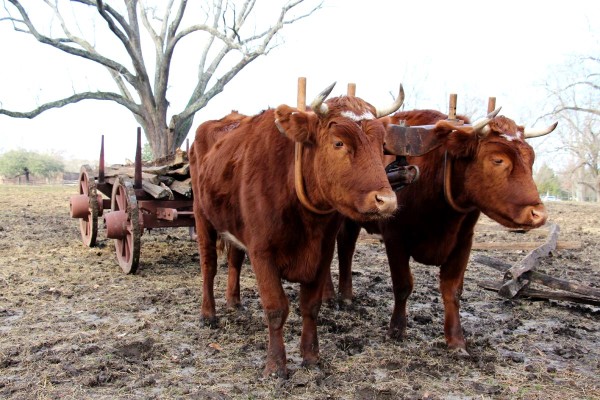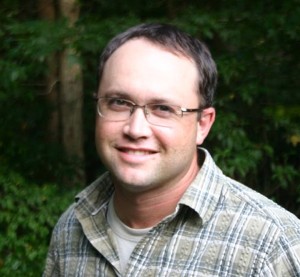
This St. Patrick’s Day, you might visit an Irish pub, frolic among shamrocks or deliver a well-deserved pinch to that non-green-wearing killjoy.
And if you happen to find yourself in the Revolutionary City, you could also catch a couple gingers named Pat and Mike hard at work.
True, Pat and Mike aren’t yet full-sized, but they’re no mischievous leprechauns, despite their Irish names and United Kingdom
lineage. For these 1,400-pound twins, March 17th is just another day at the office.
Colonial Williamsburg goes to great lengths to reproduce Virginia’s 18th-century capital correctly, so whenever possible, the labor necessary to maintain the town happens without modern mechanization. That’s where Pat and Mike come in. Part of the Foundation’s Rare Breeds program, they’re the newest pair of working cattle to offer their brawn in the service of historical accuracy.
Much like the two other ox teams who already work in the Historic Area, Pat and Mike are not just for show.
On a recent morning, ox driver Lisa Carpenter greeted Pat and Mike in the frost-hardened Custis Pasture across from the Public Hospital. The brothers finished the last few bites of their breakfast (hay, of course) before lumbering over to greet her. Mike, the more playful of the pair, nibbled at shirtsleeves and nuzzled Carpenter in hopes of a few scratches. She indulged him.
An affectionate but firm taskmaster, though, Carpenter got to work. Several chores needed attention in the Historic Area. Carpenter yoked Pat and Mike and latched on a two-wheeled cart, its sky blue paint chipped and peeling in places from many days like today.
Using a combination of body position, a 4-foot-long stick called a goad and voice commands, she drove the pair — cart and all — along a narrow, snaking path, then down Duke of Gloucester Street toward their first stop of the day.
“Back, Pat. Haw, Mike. Whoa,” she ordered, swatting their knees with her goad as the crew hustled along with seemingly little effort.
Curious passersby interrupted their progress a few times on the way; the charming 3-year-olds are eye-catching, their red coats rich and full this time of year to protect them against winter’s bitter breezes.
“Which one’s which?” is a question that Carpenter gets often, and this day was no exception. She can tell them apart by the shapes of the small white splotches on their auburn coats. But there’s another way to identify them when they’re yoked: Pat is the so-called nigh ox, who stands closest to the driver. Mike is the off ox, farther away. Their positions never change.
After a few pleasant conversations, the work detail arrived at the pasture behind Wetherburn’s Tavern, known to Colonial Williamsburg livestock aficionados as the “maternity ward” because it happens to be where pregnant ewes are often penned as the time to deliver lambs nears.
The bedding in the maternity ward’s run-in shed was due for new straw. Late winter and early spring is lambing season, after all, and it’s important to keep things tidy for the ewes that give birth there.
Using pitchforks and a dung rake, Carpenter and a couple assistants who joined her heaved the soiled straw into the cart. Pat and Mike stood idly by, still yoked, chewing cud, awaiting commands as any well-trained pair of steers would. With the old bedding swapped with fresh, Carpenter goaded the team along once more, their muscle power more than ample to haul the burden to a dump site nearby—just as 18th-century yeomen and their teams may have done.
But 21st-century historical interpreters have added duties. No sooner had the work crew left the pasture than an elementary-school group approached, wanting to know more about the hardworking beasts they happened upon. The kids brimmed with questions.
“How big do they grow?” one girl wondered.
“It depends on the breed,” Carpenter explained. “Pat and Mike are Durhams, meaning they will grow to about 2,000 pounds.”
In fact, until then, they’re known as “working steers” and will only be called oxen when they reach full size, probably sometime when they’re 4 years old. Nevertheless, the key word is “working,” as Pat and Mike must earn their keep.
“Here at Colonial Williamsburg, they do real work,” Carpenter told the children. “Soon they will be plowing at Great Hopes Plantation.”
What’s more, Pat and Mike often truck materials tradesmen need in the Historic Area: coal for the blacksmith, lumber for the carpenters, bricks for the new Market House. The work Carpenter described sounded heavy, even to young children.
“Have they ever broken that wooden thing?” asked one boy, gesturing toward the stout piece of carved wood connecting Pat and Mike by the neck.
“Their yoke?” responds Carpenter with a grin. “No, a yoke is very hard to break.”
Indeed, the few pieces of their equipment are cheap and rugged, which is why so many colonial Americans, middling as they were, preferred oxen as draft animals over horses, whose accoutrements were often out of financial reach.
As the school group moseyed in one direction, Pat and Mike went with Carpenter in another, on their way to the next errand, proving how invaluable they are to this restored 18th-century town, undertaking chores well-known to our ancestors, illuminating the past for generations who have grown from those humble beginnings.
GUEST BLOGGER: BEN SWENSON
 Ben Swenson lives in Williamsburg, Virginia with his wife and two sons. His writing career has led him to all sorts of odd corners of the world: he has jumped out of a perfectly good airplane, wrestled crab pots on a Chesapeake Bay work boat and taken a helicopter ride through a twisting river gorge. Odds are good you will find him outside with them somewhere when he is not chasing or telling stories.
Ben Swenson lives in Williamsburg, Virginia with his wife and two sons. His writing career has led him to all sorts of odd corners of the world: he has jumped out of a perfectly good airplane, wrestled crab pots on a Chesapeake Bay work boat and taken a helicopter ride through a twisting river gorge. Odds are good you will find him outside with them somewhere when he is not chasing or telling stories.
Chris Cottrill says
My family is looking forward to hopefully meeting Pat and Mike on our next visit to Williamsburg. I think that people will be able to learn a lot from watching them work and “earn their keep”.